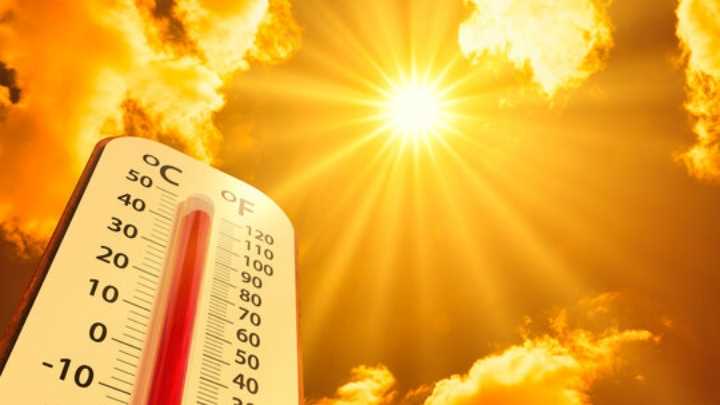
Srinagar recorded the hottest June day on Friday with the temperature rising to 35.5°C as the heatwave intensified across J&K.
“Srinagar sizzled at 35.5°C today. It hottest June day in the past 20 years—surpassing the normal temperature by 6.3°C. A day earlier Srinagar had recorded a maximum temperature of 35.2°C,” a MeT official said.
This was the highest Srinagar temperature since 2005.
“At 35.5°C, Srinagar broke yesterday's record. Today's temperature is the highest June temperature since 2005,” Kashmir’s independent weather expert said.
The all-time highest temperature in June in Srinagar stands at 37.8°C recorded on June 29, 1978.
Over the past few days Kashmir has been witnessing abnormally high temperatures across various districts, with most places recording mercury levels well above normal.
Qazigund in south Kashmir recorded a high of 34.5°C, a staggering 7.1°C above the seasonal average, while the popular tourist destination Pahalgam touched 30.0°C — 5.2°C above normal.
Kupwara in north and Kokernag in south Kashmir also faced sweltering conditions at 34.1°C and 33.6°C respectively, with both towns seeing temperature deviations of more than 4°C.
Even the usually cool Gulmarg, known for its alpine climate, recorded a high of 25.2°C, which is 5.2°C above normal.
The unprecedented heat wave has caused a sharp drop in the water level of the Jhelum River.
Since perennial water reservoirs in the mountains, which sustain the Valley during the hot summer months, have already been depleted because of lesser snowfall in winter, water level in mountain streams, springs, rivers, lakes and wells has also alarmingly fallen.
Farmers in the highlands of Ganderbal, Srinagar, Budgam, Bandipora, Kupwara, Baramulla, Shopian, Kulgam and Anantnag districts are already crying over water shortages for their Paddy fields and apple orchards.
Paddy fields in some of the higher areas have started getting adversely hit by less irrigation water.
The Paddy plant needs plenty of water till the ears fill, and it is only during the ripening of the grain and the onset of harvest that farmers can afford to have their fields dry.
Apple fruit trees also need frequent irrigation during the fruit-bearing season for succulent and colourful apples. Apples hit by water shortages are less succulent, not sufficiently colourful and with much shorter shelf lives.
Srinagar recorded the hottest June day on Friday with the temperature rising to 35.5°C as the heatwave intensified across J&K.
“Srinagar sizzled at 35.5°C today. It hottest June day in the past 20 years—surpassing the normal temperature by 6.3°C. A day earlier Srinagar had recorded a maximum temperature of 35.2°C,” a MeT official said.
This was the highest Srinagar temperature since 2005.
“At 35.5°C, Srinagar broke yesterday's record. Today's temperature is the highest June temperature since 2005,” Kashmir’s independent weather expert said.
The all-time highest temperature in June in Srinagar stands at 37.8°C recorded on June 29, 1978.
Over the past few days Kashmir has been witnessing abnormally high temperatures across various districts, with most places recording mercury levels well above normal.
Qazigund in south Kashmir recorded a high of 34.5°C, a staggering 7.1°C above the seasonal average, while the popular tourist destination Pahalgam touched 30.0°C — 5.2°C above normal.
Kupwara in north and Kokernag in south Kashmir also faced sweltering conditions at 34.1°C and 33.6°C respectively, with both towns seeing temperature deviations of more than 4°C.
Even the usually cool Gulmarg, known for its alpine climate, recorded a high of 25.2°C, which is 5.2°C above normal.
The unprecedented heat wave has caused a sharp drop in the water level of the Jhelum River.
Since perennial water reservoirs in the mountains, which sustain the Valley during the hot summer months, have already been depleted because of lesser snowfall in winter, water level in mountain streams, springs, rivers, lakes and wells has also alarmingly fallen.
Farmers in the highlands of Ganderbal, Srinagar, Budgam, Bandipora, Kupwara, Baramulla, Shopian, Kulgam and Anantnag districts are already crying over water shortages for their Paddy fields and apple orchards.
Paddy fields in some of the higher areas have started getting adversely hit by less irrigation water.
The Paddy plant needs plenty of water till the ears fill, and it is only during the ripening of the grain and the onset of harvest that farmers can afford to have their fields dry.
Apple fruit trees also need frequent irrigation during the fruit-bearing season for succulent and colourful apples. Apples hit by water shortages are less succulent, not sufficiently colourful and with much shorter shelf lives.
© Copyright 2023 brighterkashmir.com All Rights Reserved. Quantum Technologies